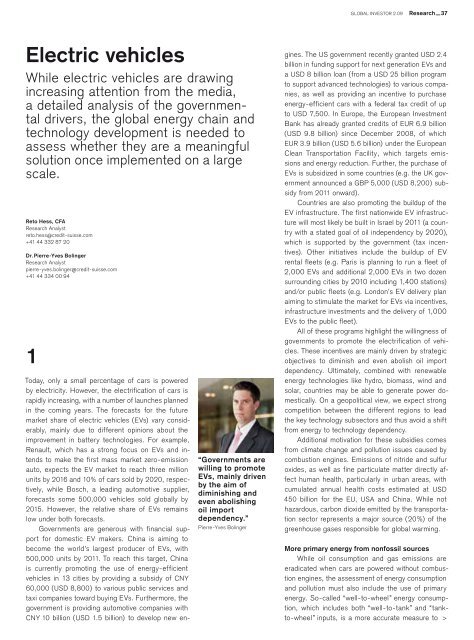Global Megatrends
Prepare yourself for the future Global Investor, 02/2009 Credit Suisse
Prepare yourself for the future
Global Investor, 02/2009
Credit Suisse
Create successful ePaper yourself
Turn your PDF publications into a flip-book with our unique Google optimized e-Paper software.
GLOBAL INVESTOR 2.09 Research — 37<br />
Electric vehicles<br />
While electric vehicles are drawing<br />
in creas ing attention from the media,<br />
a detailed analysis of the governmen -<br />
tal drivers, the global energy chain and<br />
technology de velopment is needed to<br />
assess whether they are a meaningful<br />
solution once im plemented on a large<br />
scale.<br />
Reto Hess, CFA<br />
Research Analyst<br />
reto.hess@credit-suisse.com<br />
+41 44 332 87 20<br />
Dr. Pierre-Yves Bolinger<br />
Research Analyst<br />
pierre-yves.bolinger@credit-suisse.com<br />
+41 44 334 00 94<br />
1<br />
Today, only a small percentage of cars is powered<br />
by electricity. However, the electrification of cars is<br />
rapidly increasing, with a number of launches planned<br />
in the coming years. The forecasts for the future<br />
market share of electric vehicles (EVs) vary considerably,<br />
mainly due to different opinions about the<br />
improvement in battery technologies. For example,<br />
Renault, which has a strong focus on EVs and intends<br />
to make the first mass market zero-emission<br />
auto, expects the EV market to reach three million<br />
units by 2016 and 10% of cars sold by 2020, respectively,<br />
while Bosch, a leading automotive supplier,<br />
forecasts some 500,000 vehicles sold globally by<br />
2015. However, the relative share of EVs remains<br />
low under both forecasts.<br />
Governments are generous with financial support<br />
for domestic EV makers. China is aiming to<br />
become the world’s largest producer of EVs, with<br />
500,000 units by 2011. To reach this target, China<br />
is currently promoting the use of energy-efficient<br />
vehicles in 13 cities by providing a subsidy of CNY<br />
60,000 (USD 8,800) to various public services and<br />
taxi companies toward buying EVs. Furthermore, the<br />
government is providing automotive companies with<br />
CNY 10 billion (USD 1.5 billion) to develop new en-<br />
“Governments are<br />
willing to promote<br />
EVs, mainly driven<br />
by the aim of<br />
diminishing and<br />
even abolishing<br />
oil import<br />
dependency.”<br />
Pierre-Yves Bolinger<br />
gines. The US government recently granted USD 2.4<br />
billion in funding support for next generation EVs and<br />
a USD 8 billion loan (from a USD 25 billion program<br />
to support advanced technologies) to various companies,<br />
as well as providing an incentive to purchase<br />
energy-efficient cars with a federal tax credit of up<br />
to USD 7,500. In Europe, the European Investment<br />
Bank has already granted credits of EUR 6.9 billion<br />
(USD 9.8 billion) since December 2008, of which<br />
EUR 3.9 billion (USD 5.6 billion) under the European<br />
Clean Transportation Facility, which targets emissions<br />
and energy reduction. Further, the purchase of<br />
EVs is subsidized in some countries (e.g. the UK government<br />
announced a GBP 5,000 (USD 8,200) subsidy<br />
from 2011 onward).<br />
Countries are also promoting the buildup of the<br />
EV infrastructure. The first nationwide EV infrastructure<br />
will most likely be built in Israel by 2011 (a country<br />
with a stated goal of oil independency by 2020),<br />
which is supported by the government (tax incentives).<br />
Other initiatives include the buildup of EV<br />
rental fleets (e.g. Paris is planning to run a fleet of<br />
2,000 EVs and additional 2,000 EVs in two dozen<br />
surrounding cities by 2010 including 1,400 stations)<br />
and/or public fleets (e.g. London’s EV delivery plan<br />
aiming to stimulate the market for EVs via incentives,<br />
infrastructure investments and the delivery of 1,000<br />
EVs to the public fleet).<br />
All of these programs highlight the willingness of<br />
governments to promote the electrification of vehicles.<br />
These incentives are mainly driven by strategic<br />
objectives to diminish and even abolish oil import<br />
dependency. Ultimately, combined with renewable<br />
energy technologies like hydro, biomass, wind and<br />
solar, countries may be able to generate power domestically.<br />
On a geopolitical view, we expect strong<br />
competition between the different regions to lead<br />
the key technology subsectors and thus avoid a shift<br />
from energy to technology dependency.<br />
Additional motivation for these subsidies comes<br />
from climate change and pollution issues caused by<br />
combustion engines. Emissions of nitride and sulfur<br />
oxides, as well as fine particulate matter directly affect<br />
human health, particularly in urban areas, with<br />
cumulated annual health costs estimated at USD<br />
450 billion for the EU, USA and China. While not<br />
hazardous, carbon dioxide emitted by the transportation<br />
sector represents a major source (20%) of the<br />
greenhouse gases responsible for global warming.<br />
More primary energy from nonfossil sources<br />
While oil consumption and gas emissions are<br />
eradicated when cars are powered without combustion<br />
engines, the assessment of energy consumption<br />
and pollution must also include the use of primary<br />
energy. So-called “well-to-wheel” energy consumption,<br />
which includes both “well-to-tank” and “tankto-wheel”<br />
inputs, is a more accurate measure to >

















